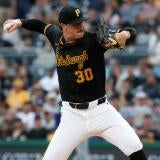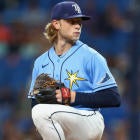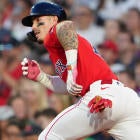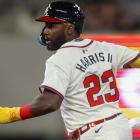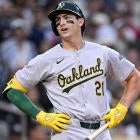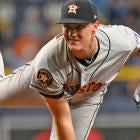
After his first five career starts, Jared Jones looked like the next great ace pitcher in MLB, and one of the potential league-winning waiver-wire adds in Fantasy Baseball. Across those five starts, he struck out 39 batters and walked just four over 29 innings, with a 2.79 ERA and 0.83 WHIP.
Since? Well, Jones hasn't been bad, certainly. He has a 3.57 ERA and 1.21 WHIP over his past eight starts, and if you just got that the rest of the way from Jones, he'd be one of the better waiver-wire pickups of the year. Just not the difference maker you thought you were getting when we all rushed to the wire to pick him up back in April – especially not with 40 strikeouts to 14 walks in 45.1 innings in that span.
What's changed, and can Jones be counted on to get back to that early-season success?
If you dig into the pitch-level data, one thing stands out immediately: Jones' fastball just hasn't been as effective as it was early in the season:
Usage | Velocity | xwOBA | Whiff% | |
April | 47.2 | 97.3 | 0.324 | 34.1 |
May | 48.9 | 97.1 | 0.353 | 23.1 |
June | 52.2 | 97.9 | 0.384 | 25.5 |
For context, the league average xwOBA for a four-seam fastball this season is .342, while the whiff rate is 21.7%. Which is to say that, while his fastball wasn't great in May, it wasn't terrible – slightly worse results on balls in play, but more whiffs than average. June has been a problem, clearly, though, with a two-start sample, it's hard to draw too many conclusions.
The physical characteristics of the pitch haven't changed too much as the season has gone on, which is one reason to be optimistic. His velocity has fluctuated a bit, both from start to start and within starts, but on the whole has been pretty consistently elite. And his spin rate on the pitch hasn't really changed either, though he has lost about two inches of vertical movement on the four-seamer – which, along with a slightly lower arm slot could explain some of why he's been a bit less effective:
Month | Vertical Movement (in) | Pitch (MPH) | Spin (RPM) | Vertical Release Pt (ft) |
Apr | 18 | 97.3 | 2530 | 5.56 |
May | 17.5 | 97.1 | 2540 | 5.5 |
Jun | 16 | 97.9 | 2541 | 5.35 |
Similarly, Jones' slider has been a bit less effective as the season has gone on, though it remains an absolutely elite pitch:
Usage | Velocity | xwOBA | Whiff% | |
April | 38.6 | 88.6 | 0.264 | 44.1 |
May | 38.2 | 88.1 | 0.2 | 35.4 |
June | 28.3 | 90 | 0.243 | 37.5 |
It seems like the fastball is the biggest issue here, though it's also worth noting that, because his repertoire is kind of limited, Jones' success might be more sensitive to what might otherwise be relatively small changes in pitch quality for his two main offerings. Jones technically throws four pitches – and he manipulates both the shape and velocity of his slider depending on the count – but the curveball and changeup are a pretty small part of the arsenal. He throws them about 14% of the time, though that number has climbed to 19.5% through two June starts, entirely because he's been throwing his changeup more. This brings up one other issue for Jones: He's starting to struggle with lefties.
In April, Jones limited left-handed hitters to a .159/.192/.377 line and a 35.6% strikeout rate and 4.1% walk rate; since the start of May, lefties are hitting .286/.351/.500 against him. The strikeout rate is still pretty solid at 26%, but the walk rate has also jumped to 9.1% against lefties, and he's giving up a ton of batted balls in the air as well, with just a 30% groundball rate against lefties.
Jones has tried both the changeup and curveball to try to minimize that platoon issue, throwing both pitches significantly more against lefties; as a right-handed pitcher, his fastball and slider are more than good enough to handle same-handed batters. But he's searching for answers against lefties, especially since his xwOBA with his four-seamer has gone from .272 against lefties in April to over .400 since.
The curveball has not really been the answer, hence the increased changeup usage. It's still a small sample size of just 48 pitches, but lefties are hitting Jones' curveball hard and aren't swinging and missing very much against it. The changeup hasn't been dominant, but a .303 expected wOBA and 27.3% whiff rate is decent enough, especially when the slider has remained incredibly effective against lefties. Maybe the answer is just to use the slider relatively equally vs. batters on both sides of the plate, given his .176 expected wOBA and 47.2% whiff rate with the slider to lefties. Mixing in more of those and the changeup and less of the fastball might help.
All in all, there are concerns here for Jones, and they are fairly natural ones. He's a rookie starting pitcher, after all, and one with a still-developing arsenal who is still trying to figure out the best path to success. He's still figuring out how to get major-league hitters out, and struggling with platoon issues isn't exactly a surprise, especially for someone with a dominant slider and very good fastball, which has been enough for most of his career.
He'll have to make adjustments, and we're already seeing signs that he's trying to. There's no guarantee that Jones will effectively make the changes he needs to, but I'm still confident there is ace upside here. He may not consistently get to it every time out, but if the "bad times" still come with a mid-3.00s ERA, it's hard to complain too much.
Jones remains an incredible talent, and it makes sense to bet on incredible talents figuring it out. If there's an opportunity to buy low here, I think I'm going to take it — especially if he struggles in Coors Field this week — because there's still top-12 upside here.











